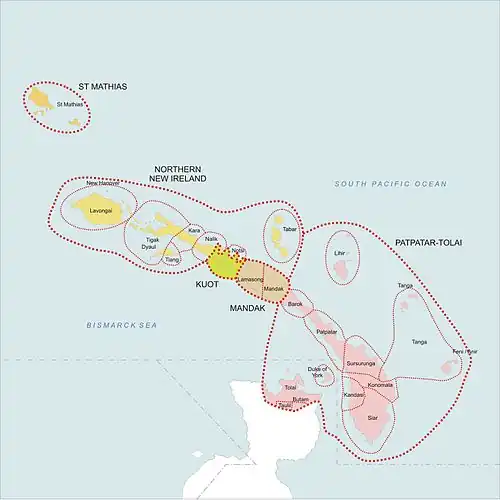Tigak language
| Tigak | |
|---|---|
| Region | New Ireland Province, Papua New Guinea |
Native speakers | (6,000 cited 1991)[1] |
Austronesian
| |
| Latin | |
| Language codes | |
| ISO 639-3 | tgc |
| Glottolog | tiga1245 |

Tigak (or Omo) is an Austronesian language spoken by about 6,000 people (in 1991)[2] in the Kavieng District of New Ireland Province, Papua New Guinea.
The Tigak language area includes the provincial capital, Kavieng.
Phonology
Phoneme inventory of the Tigak language:
| Labial | Alveolar | Velar | ||
|---|---|---|---|---|
| Nasal | m | n | ŋ | |
| Plosive | voiceless | p | t | k |
| voiced | b | g | ||
| Rhotic | r | |||
| Fricative | voiceless | β | s | |
| lateral | ɮ | |||
/r/ can also be realized as [ɾ] allophonically. Both /k, ɡ/ are back-released as [k̠, ɡ̠].
| Front | Central | Back | |
|---|---|---|---|
| High | i | u | |
| Mid | e | ɔ | |
| Low | a |
| Phoneme | Allophones |
|---|---|
| /i/ | [i], [ɪ], [y] |
| /e/ | [e], [ɛ] |
| /a/ | [ʌ], [a] |
Two vowels /i u/ in word-initial form can also be released as consonantal allophones [w j].[3]
External links
References
- ^ Tigak at Ethnologue (18th ed., 2015) (subscription required)
- ^ Gordon, Raymond G. Jr., ed. (2005). "Tigak". Ethnologue: Languages of the World (fifteenth ed.). Dallas: SIL.
{{cite book}}: External link in|chapter= - ^ Beaumont, Clive H. (1974). The Tigak Language of New Ireland. Australian National University.
{{cite book}}: CS1 maint: location missing publisher (link)